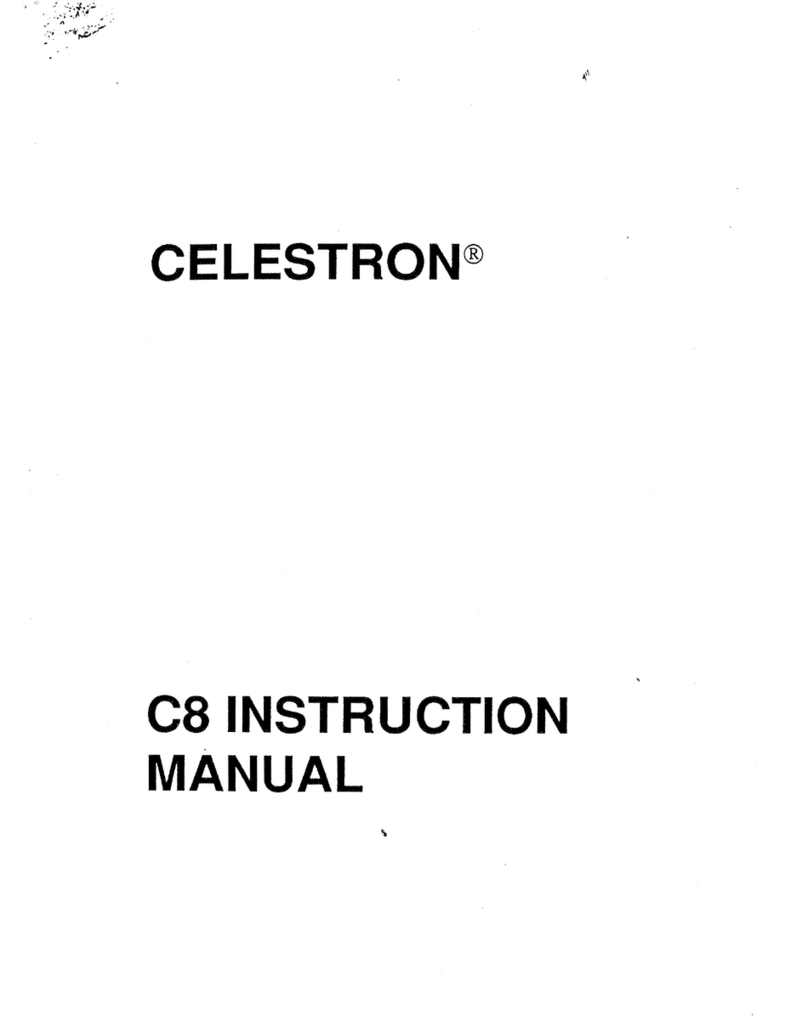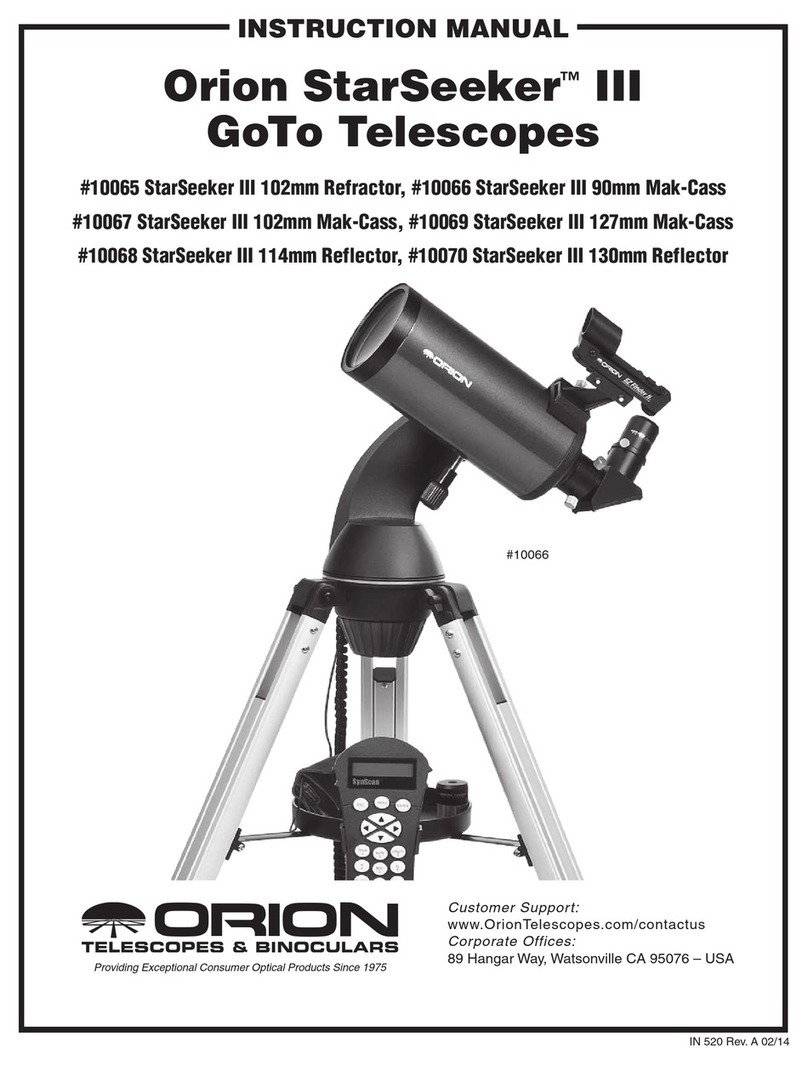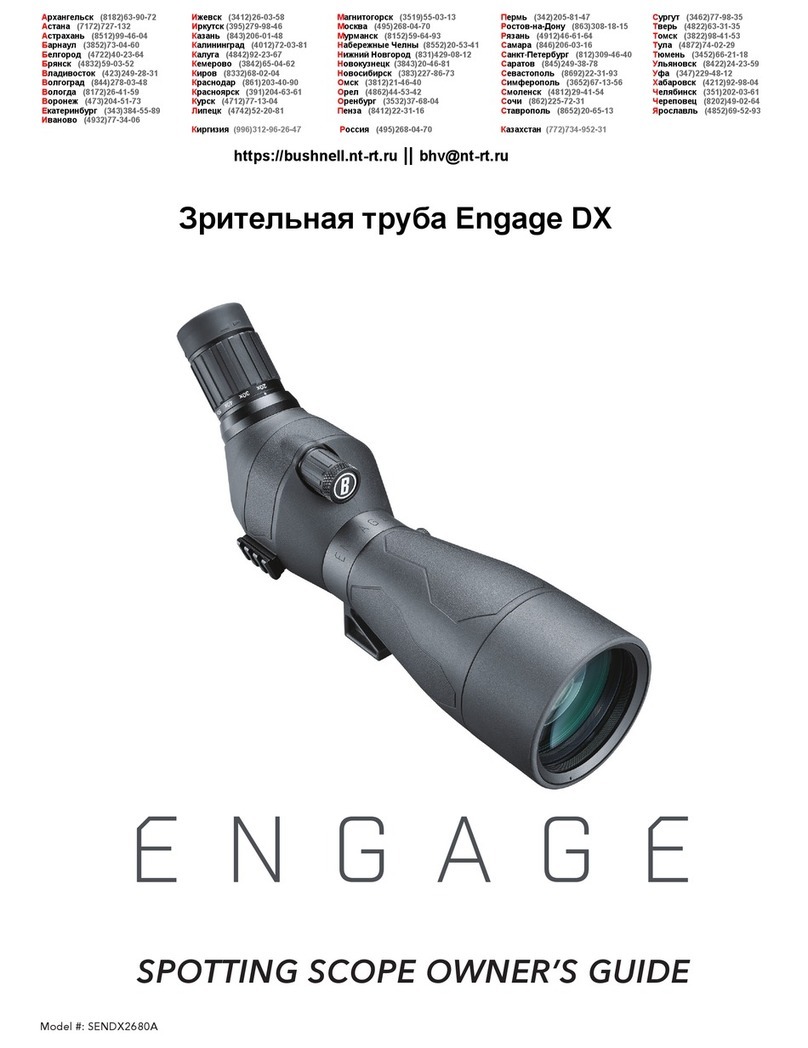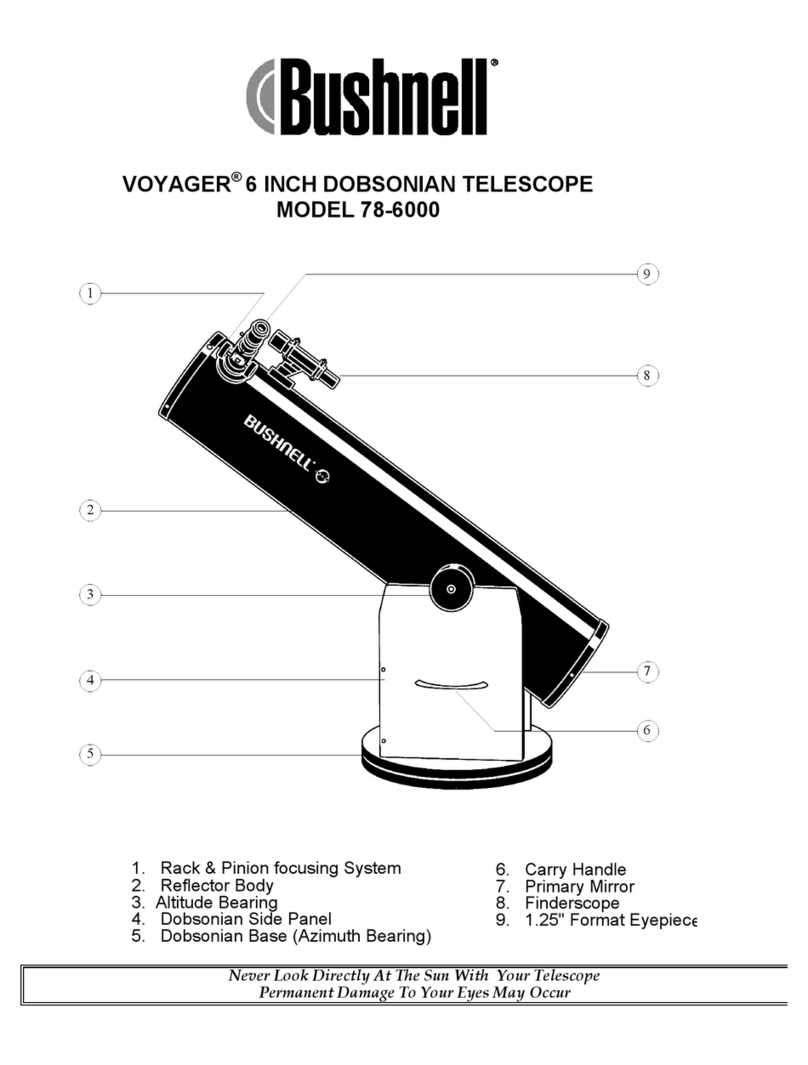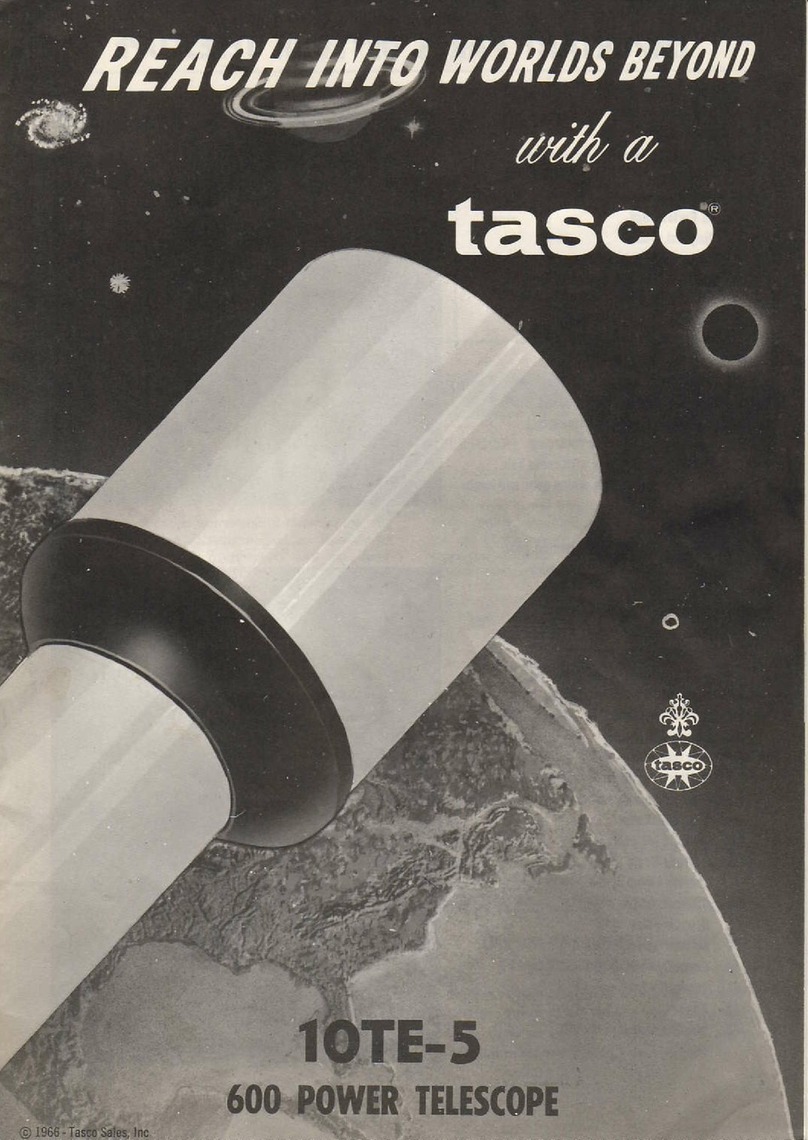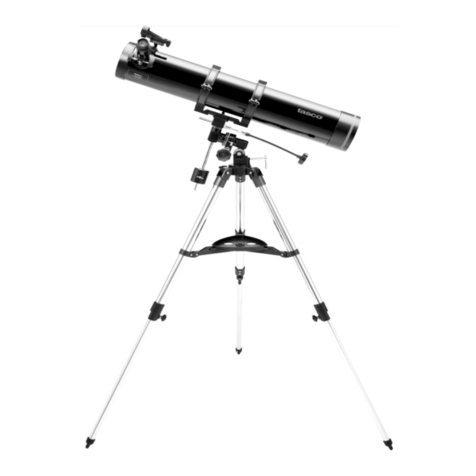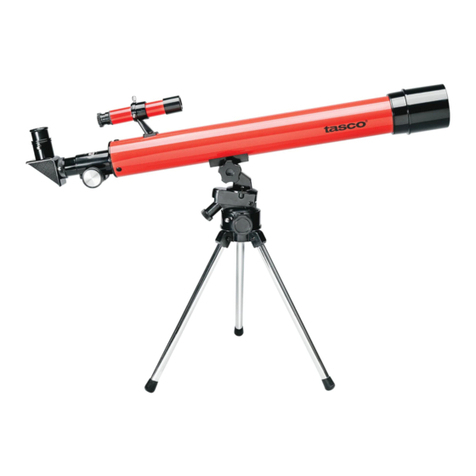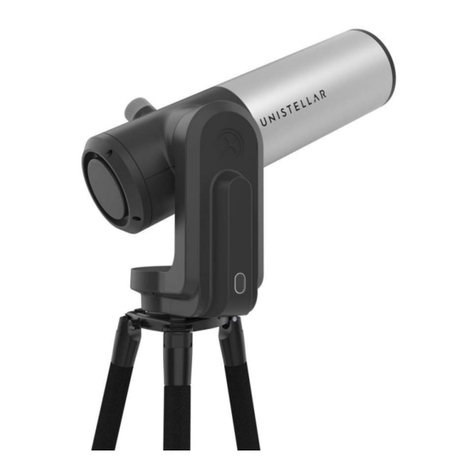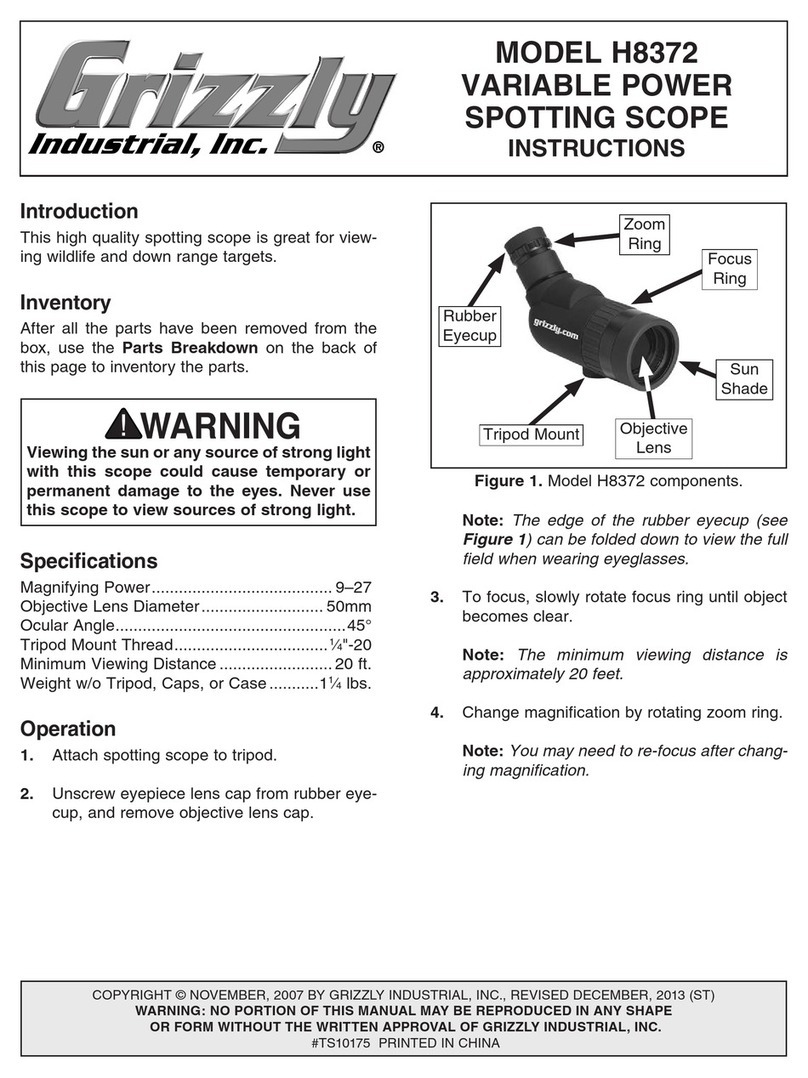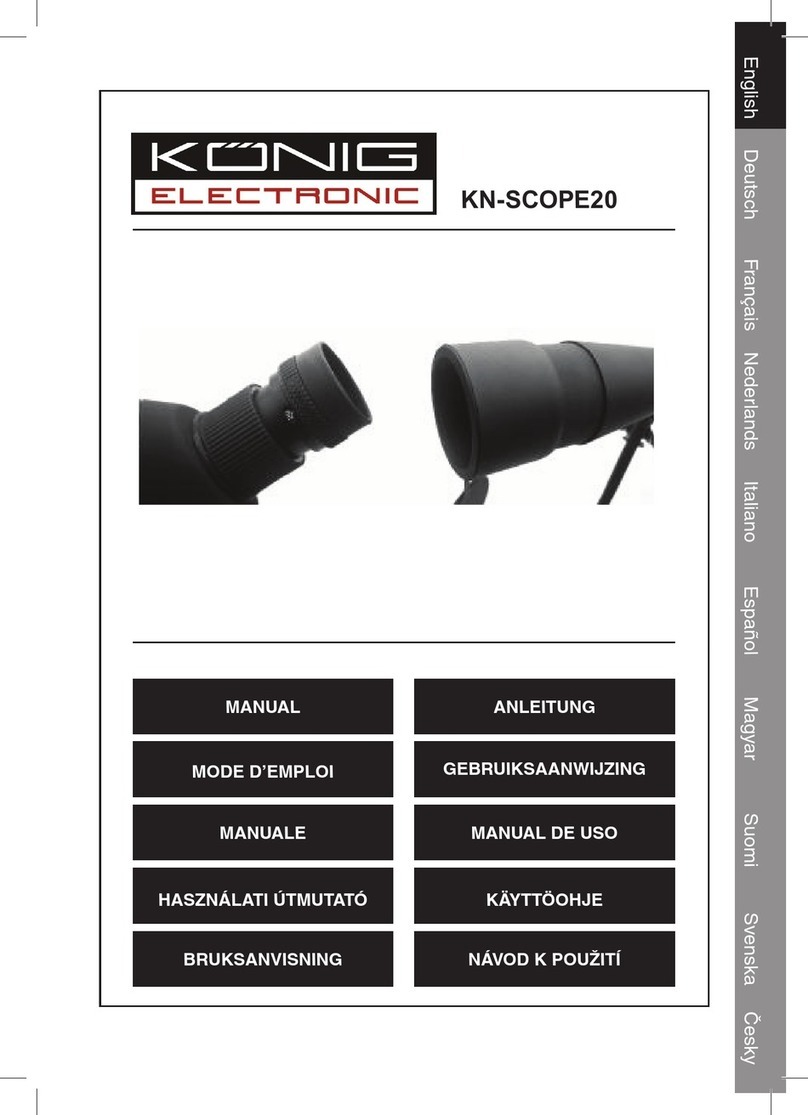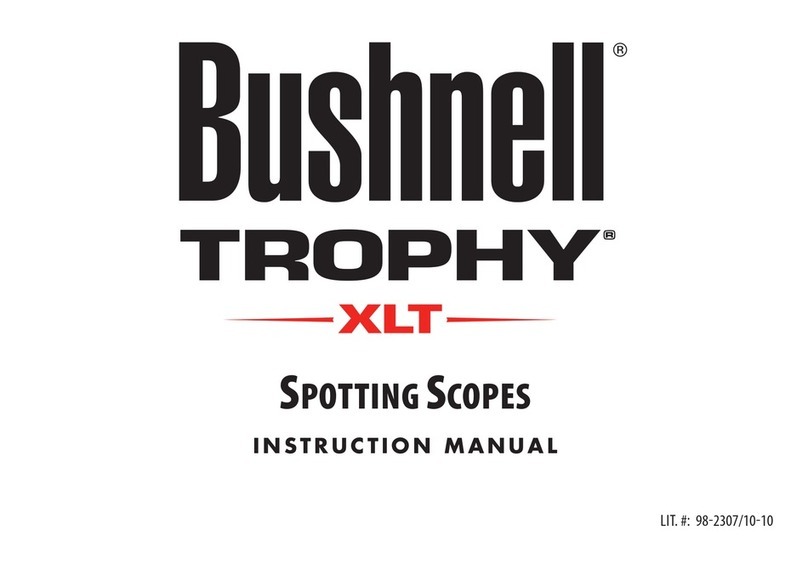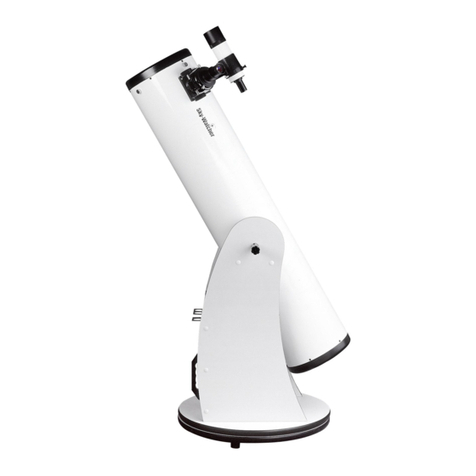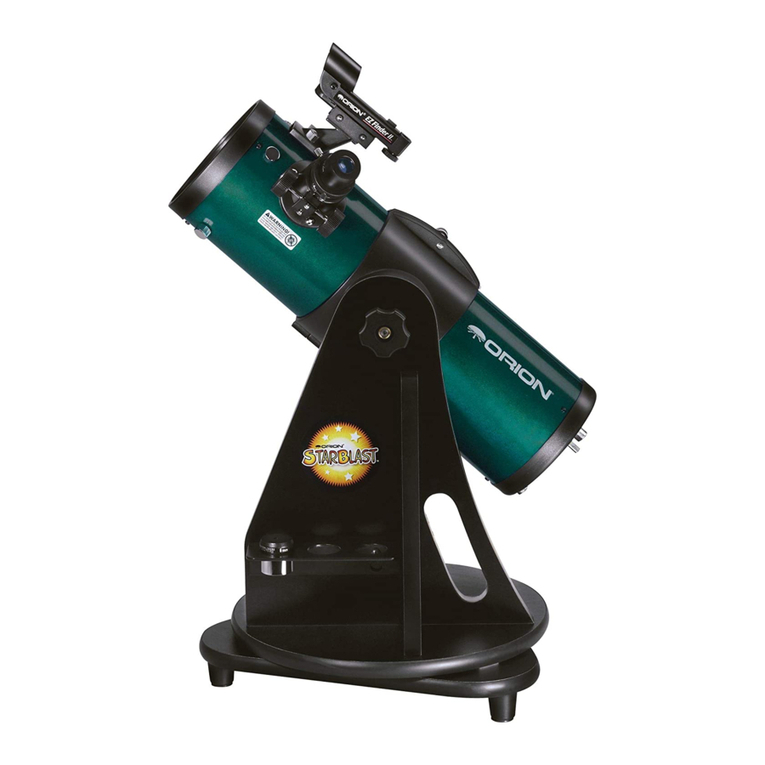Explore One CF400SP User manual

CF400SP TELESCOPE
1
70 mm Telescope Pan Handle AZ Mount
w/Smartphone Adapter
Instruction Manual
Specifications
Optical Design
Magnification
Front Lens (clear aperture)
Focal Length
Standard Eyepieces
Finish
Tripod
Achromatic Refractor
20 - 67x
70 mm
400 mm
1.25” K6 mm & K20 mm
Carbon Fiber Wrap Design
Alt-azimuth Tripod
88-10073CF
AGES
10 +
INCLUDED
X
1
CR2032
3V This product can expose you to chemicals including lead,
which is known to the State of California to cause cancer.
For more information go to www.P65Warnings.ca.gov.
WARNING:
SUN HAZARD
— Never look directly at the sun
with this device.
WARNING:
The lens contains lead that may be harmful.
Wash hands after touching.
WARNING:
Contains button or coin cell battery.
Hazardous if swallowed
— see instructions.
WARNING:
CHOKING HAZARD
— Small parts.
Not for children under 3 years.
WARNING:

2
Customer Service: Call 1-866-252-3811
Instruction Manual, &
Downloadable Planisphere Visit:
www.exploreone.com/pages/product-manuals
BUTTON/COIN BATTERY WARNING
WARNING:
This product contains a Button or Coin Cell Battery. A swallowed
Button or Coin Cell Battery can cause internal chemical burns in as little
as two hours and lead to death. Dispose of used batteries immediately.
Keep new and used batteries away from children. If you think batteries
might have been swallowed or placed inside any part of the body, seek
immediate medical attention.
WARNING: NEVER ATTEMPT TO OBSERVE THE SUN WITH THIS DEVICE! OBSERVING THE
SUN – EVEN FOR A MOMENT – WILL CAUSE INSTANT AND IRREVERSIBLE DAMAGE TO
YOUR EYE OR EVEN BLINDNESS. EYE DAMAGE IS OFTEN PAINLESS, SO THERE IS NO
WARNING TO THE OBSERVER THAT THE DAMAGE HAS OCCURRED UNTIL IT IS TOO LATE.
DO NOT POINT THE DEVICE AT OR NEAR THE SUN. DO NOT LOOK THROUGH THE DEVICE AS
IT IS MOVING. CHILDREN SHOULD ALWAYS HAVE ADULT SUPERVISION WHILE OBSERVING.
SUN WARNING
SAFETY WARNINGS
• RESPECT PRIVACY: WHEN
USING THIS DEVICE, RESPECT
THE PRIVACY OF OTHER
PEOPLE. FOR EXAMPLE, DO
NOT USE THEM TO LOOK
INTO PEOPLE’S HOMES.
• CHOKING HAZARD:
CHILDREN SHOULD ONLY
USE DEVICE UNDER ADULT
SUPERVISION. KEEP
PACKAGING MATERIALS
LIKE PLASTIC BAGS AND
RUBBER BANDS OUT OF
THE REACH OF CHILDREN
AS THESE MATERIALS POSE
A CHOKING HAZARD.
• RISK OF BLINDNESS:
NEVER USE THIS DEVICE
TO LOOK DIRECTLY AT THE
SUN OR IN THE DIRECT
PROXIMITY OF THE SUN.
DOING SO MAY RESULT IN A
PERMANENT LOSS OF VISION.
• RISK OF FIRE: DO
NOT PLACE DEVICE,
PARTICULARLY THE LENSES,
IN DIRECT SUNLIGHT. THE
CONCENTRATION OF LIGHT
RAYS COULD CAUSE A FIRE.
• DO NOT DISASSEMBLE THIS
DEVICE. IN THE EVENT OF A
DEFECT, PLEASE CONTACT
YOUR DEALER. THE DEALER
WILL CONTACT THE CUSTOMER
SERVICE DEPARTMENT AND
CAN SEND THE DEVICE IN TO
BE REPAIRED IF NECESSARY.
• DO NOT SUBJECT THE
DEVICE TO TEMPERATURES
EXCEEDING 60 °C 140 °F.
• DISPOSAL: KEEP PACKAGING
MATERIALS, LIKE PLASTIC
AND RUBBER BANDS,
AWAY FROM CHILDREN AS
THEY A POSE A RISK OF
SUFFOCATION. DISPOSE
OF PACKAGING MATERIALS
AS LEGALLY REQUIRED.
CONSULT THE LOCAL
AUTHORITY ON THE MATTER
IF NECESSARY AND RECYCLE
MATERIALS WHEN POSSIBLE.
READ AND FOLLOW THE INSTRUCTIONS, SAFETY RULES, AND FIRST AID INFORMATION.

3
Parts Overview
1. 70mm Objective Lens
2. Pan- Tilt Alt-Azimuth Mount
3. Tripod with Accessory Tray
4. Optical Tube Assembly with Dew Shield
5. Focus Wheel
6. 45⁰ Erecting Prism Diagonal
7. 1.25” Eyepieces (K6 mm & K20 mm)
8. Red Dot Viewfinder
9. Smartphone Adapter
1
2
76
3
4
5
6
7
8
9

4
How To Set Up
Assembly:
Note: We recommend assembling your telescope for the first time in the daylight or in a lit room so that you can familiarize
yourself with assembly steps and all components.
1. Open the tripod until the tripod spreaders are fully extended. Put the accessory tray in place and turn
it clockwise until stable. To set the tripod height, turn the pressure fitting on each leg counterclockwise
until loose. Extend or retract the leg to the desired setting, then tighten the pressure fitting until snug.
2. Thread the panhandle clockwise onto the tripod head.
3. Set the optical tube assembly on the tripod head and align the tab on the bottom of the telescope tube
with the slot in the tripod head. Thread the front tension wheel until snug, then tighten the side tension
thumbscrew. Be careful not to over-tighten either thumbscrew.
4. Insert the diagonal into the focuser and secure it by tightening the thumbscrews.
5. To install the bracket for the red dot viewfinder, remove the two metal thumbscrews on the top of the
telescope tube. Place the bracket in position over the holes, replace the thumbscrews and tighten until
secure. Be careful not to over-tighten either thumbscrew.
6. After installing the bracket, slide the red dot viewfinder into the bracket and secure it by tightening
the three screws around the ring.
7. Place your chosen eyepiece into the diagonal. We recommend starting with the 20mm because it will
provide the widest field of view.
Telescope Terms To Know:
Diagonal: A mirror that deflects the ray of light 90 degrees.
With a horizontal telescope tube, this device deflects the light upwards so
that you can comfortably observe by looking downwards into the eyepiece.
The image in a diagonal mirror appears upright, but rotated around its
vertical axis (mirror image).
Focal length: Everything that magnifies an object via an optic lens has a certain focal length. The focal
length is the length of the path the light travels from the surface of the lens to its focal point. The focal
point is also referred to as the focus. In focus, the image is clear. In the case of a telescope, the focal
length of the telescope tube and the eyepieces are used to determine magnification.
Lens: The lens turns the light that falls on it around in such a way so that the light gives a clear image in
the focal point after it has traveled a certain distance (focal length).
Eyepiece: An eyepiece is a system made for your eye and comprised of one or more lenses. In an
eyepiece, the clear image that is generated in the focal point of a lens is captured and magnified still
more.
Magnification: The magnification corresponds to the difference between observation with the naked
eye and observation through a magnifying device like a telescope. If a telescope configuration has a
magnification of 30x, then an object viewed through the telescope will appear 30 times larger than it
would with the naked eye. To calculate the magnification of your telescope setup, divide the focal length
of the telescope tube by the focal length of the eyepiece.
NOTE:
The magnifying power of a telescope is determined by dividing the focal length of the telescope by
the focal length of the eyepiece. This means that as the focal length of your eyepiece increases, the
magnifying power decreases.

5
Using/Aligning the Red Dot Viewfinder:
The viewfinder is powered by a CR-2032 battery that is included. Before using the viewfinder for the first
time, remember to remove the plastic insulator that is blocking the battery from connecting.
When it is time to replace the battery, remove the battery cap by loosening the set screw. Take out the
old battery and slide a new battery in place with the positive side showing. Replace the cap, and tighten
the set screw.
For The Viewfinder To Be Effective, It Must Be Aligned. To do this:
• Insert the 20 mm eyepiece into the
diagonal and power on the viewfinder
by sliding the switch on its right side to
an “On” position.
• Point the eyepiece at an easy to identify
target like a telephone pole that is
approximately 200 yards away. Center
the object in the eyepiece. Lock the
telescope into place by tightening the
panhandle.
• Without moving the telescope, position
the red dot using the two adjustment
screws so that it shares the same view
as the one in your eyepiece. The front
screw will move the viewfinder up and
down, and the other will move it side to
side. Your viewfinder is now aligned.
Note: To preserve battery life, don’t forget
to turn off the viewfinder after use.
Using Your Telescope:
After you have assembled your telescope, you are ready to start observing. Put the 20mm eyepiece
into the diagonal to get the widest field of view. This wider field of view will make it easier to locate
and track objects.
To move the scope up, down and side to side, loosen the locking screws slightly and grip the telescope
near where the tube meets the focuser and steadily move the tube until your target comes into view in
the eyepiece. Once you have found and focused on your desired target, you can lock the telescope into
position by tightening the two locating screws.
It is important to remember that the rotation of the Earth means objects will move out of your
eyepiece fairly quickly.
For a closer look at an object, you can insert the K6 mm eyepiece. The magnification will increase
from 20x to 67x.
Cleaning:
Your telescope is a precision optical device and keeping the optics free of dust and dirt is crucial for
optimal performance. To clean the lenses (objective and eyepiece) use only a photo-grade soft brush
or a lint-free cloth, like a microfiber cloth. Do not press down too hard while cleaning, as this might
scratch the lens. Ask your parents to help if your telescope is really dirty. If necessary, the cleaning
Fig. 1 Fig. 2
Front
Red Dot Viewfinder
(bottom view)
El Visor Red Dot es
impulsado por un tipo de batería
CR-2032 (3V); si un reemplazo es
necesario, retire la tapa (fig. 1),
desenroscando el tornillo de ajuste
(fig. 2) y la batería de deslizamiento
hacia la parte delantera. Deslice la
pila en el lugar con la positiva
proyección lateral (+). Reemplace
la tapa y apriete con
el tornillo de
fijación (fig. 2).
fig. 1 fig. 2
frente
Red Dot visor
(vista desde abajo)
English
Le viseur point rouge est
alimenté par une batterie de type
CR-2032 (3V), si un remplacement
est nécessaire, enlever le bouchon
(Fig. 1) en dévissant la vis de
réglage (Fig. 2) et la batterie de
glissement vers l'avant. Glisser la
nouvelle pile en place avec la
borne positive (+) côté montrant.
Remettre le bouchon et
le serrer avec
la vis de
pression
(Fig. 2).
Fig. 1 Fig. 2
Devant
Red Dot Viseur
(vue de dessous)
FrenchSpanish
紅點觀景器由一顆 CR-2032
(3V) 型電池供電;如需要換電池
,鬆開固定螺絲 (Fig.2) 移除蓋
子 (Fig.1),並將電池往前推。接
著陽極面 (+) 向上推入新電池。
蓋回蓋子並轉緊固定螺絲
(Fig.2)。
fig. 1 fig. 2
前方
紅點觀景器(底部視角)
Chinese Traditional
赤点ファインダーは付属の
CR-2032電池 (3V) で駆動してい
ます。電池交換の際は、位置決め
ネジ (図2) を緩めて電池キャップ
(図1) を取り外します。古い 電池を
前に向かってスライドさせ、新し
い電池を+面を表にして入れ、キ
ャップを戻してネジ (図2) をしめ
てください。
図1図2
前部
赤 点 ファインダ ー
(下面図)
Japanese
The Red Dot Viewfinder is
powered by a battery type
CR-2032 (3V); if a replacement is
necessary, remove the cap (Fig. 1)
by unscrewing the set screw (Fig.
2) slide the battery towards the
front. Slide the new battery in with
the positive (+) side showing.
Replace the cap and tighten the
set screw (Fig. 2).
Please recycle
batteries responsibly.

cloth can be moistened with an optical glass cleaning fluid and the lens wiped clean using very little
pressure. Do not use harsh detergents!
Make sure your telescope is always protected against dust and dirt.
After use, leave it in a warm room to dry off before storing.
Possible Objects For Observation:
Terrestrial Objects
Take note of the examples below, including Mount Rushmore and the golf course. Start with
the K20 mm eyepiece and focus until the image is clear. After
mastering the K20 mm eyepiece, switch to the K6 mm eyepiece
and practice scanning and focusing until the image is clear. Choose
several terrestrial objects to practice focusing on, but never point
your telescope at or near the sun, or you risk blindness.
The Moon
Diameter: 3,476 km
Distance: Approximately 384,401 km
The Moon is the Earth’s only natural satellite, and it is the second brightest
object in the sky (after the Sun). Although it is our closest neighbor, a lot
of people have never really taken a good long like at the Moon. With your
telescope, you should be able to see several interesting lunar features.
These include lunar maria, which appear as vast plains, and some of the
larger craters. The best views will be found along the terminator, which
is the edge where the visible and cloaked portions of the Moon meet.
6
Troubleshooting Guide:
Problem Solution
No picture Remove dust protection cap and sun-shield from the objective
opening.
Blurred picture Adjust focus using focus ring.
No focus possible Wait for temperature to balance out.
Bad quality Never observe through a glass surface such as a window.
Viewing object visible in the finder, but not
through the telescope Align finder to telescope (see instructions)
Despite using star diagonal prism the
picture is “crooked”
The star diagonal prism should be vertical in the eyepiece
connection.
f=K20 mm f=K6 mm
The Moon
f=K20 mm f=K6 mm
Terrestrial Images

7
Using the Smartphone Adapter:
SUPERVISION BY ADULTS
Read and follow the instructions, safety rules and first aid information
The Smartphone Adapter will allow you to connect almost any “smart” device to a 1.25” eyepiece.
To use the adapter, place it directly onto the selected eyepiece and secure it by tightening the setscrew
until snug. Be careful not to overtighten because this could damage the adapter and/or the eyepiece.
The camera lens on your smart device will need to be centered over the eyepiece. This alignment is best
done by opening the camera function and viewing the image while you center the device. Once you have
positioned the device correctly, carefully press it onto the suction cup/non-skid surface of the adapter
pad. Never allow the adapter pad to hold your device without you supporting the item as well.
The point at which you secure the eyepiece/adapter combination into the diagonal depends largely on
the dimensions of your device. For smaller devices like smart phones, it may be easier to secure it to
the eyepiece/adapter combination before inserting the entire unit into the diagonal on the telescope.
For larger devices, such as tablets, it may be easier to secure the eyepiece/adapter combination into the
diagonal, and then align and attach your device.
After positioning your device and capturing images, you can enhance and edit the photos using the
imaging software of your choice. One option can be found at https://www.getpaint.net/.
WARNING: Do not leave your device unsupported or unattended on the adapter pad.
Though the surface of the adapter pad is designed with suction cups and is non-skid, the manufacturer
cannot assure that the pad will support the weight of various devices or guarantee that it will adhere to
all surfaces on various smart devices. The pad is not intended to secure, balance or support the device
on its own, and the operator should not let the device rest solely on the adapter pad. Leaving the device
unattended or allowing it to balance on its own without operator support may result in the device falling,
unbalancing the entire instrument and possibly damaging the telescope or your smart device.
CHEMICALS
Any chemicals and liquids used in preparing, using, or cleaning should be kept out of reach of children.
Do not drink any chemicals. Hands should be washed thoroughly under running water after use. In case
of accidental contact with the eyes or mouth rinse with water. Seek medical treatment for ailments
arising from contact with the chemical substances and take the chemicals with you to the doctor.
Keep packaging materials (plastic bags, rubber bands, etc.) away from children. There is a risk of
SUFFOCATION.
Dispose of packaging materials as legally required. Consult the local authority on the matter if
necessary.
DISPOSAL
Dispose of the packaging materials properly, according to their type, such as paper or cardboard.
Contact your local waste-disposal service or environmental authority for information on the proper
disposal. Please take the current legal regulations into account when disposing of your device. You can
get more information on the proper disposal from your local waste-disposal service or environmental
authority.

8
©2018 Explore Scientific, LLC.
1010 S. 48th Street, Springdale AR 72762
All rights reserved. explorescientificusa.com | exploreone.com |
866.252.3811
Made in China
CONFORMS TO THE SAFETY REQUIREMENTS OF ASTM F963
Colors and styles may vary.
EN
• The WEEE symbol if present indicates that
this item contains electrical or electronic
components which must be collected and
disposed of separately.
• Never dispose of electrical or electronic waste
in general municipal waste. Collect and dispose
of such waste separately.
• Make use of the return and collection systems available to you, or
your local recycling program. Contact your local authority or place of
purchase to nd out what schemes are available.
• Electrical and electronic equipment contains hazardous substance
which, when disposed of incorrectly, may leak into the ground.
This can contribute to soil and water pollution which is hazardous to
human health, and endanger wildlife.
• It is essential that consumers look to re-use or recycle electrical
or electronic waste to avoid it going to landll sites or incineration
without treatment.
Other manuals for CF400SP
1
Table of contents
Other Explore One Telescope manuals
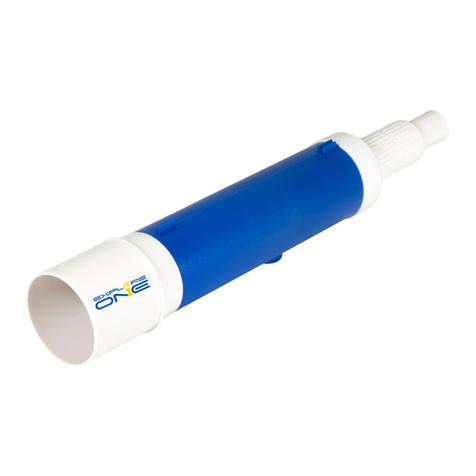
Explore One
Explore One 88-50ERTK User manual
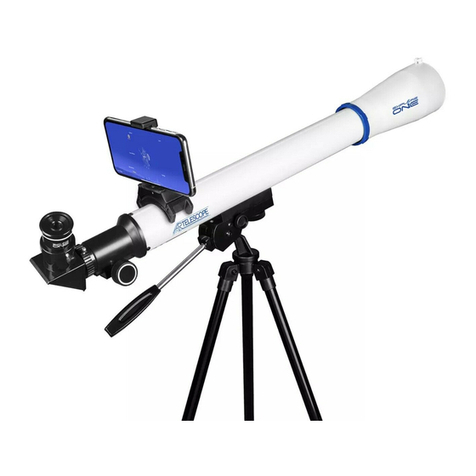
Explore One
Explore One STAR50APP User manual
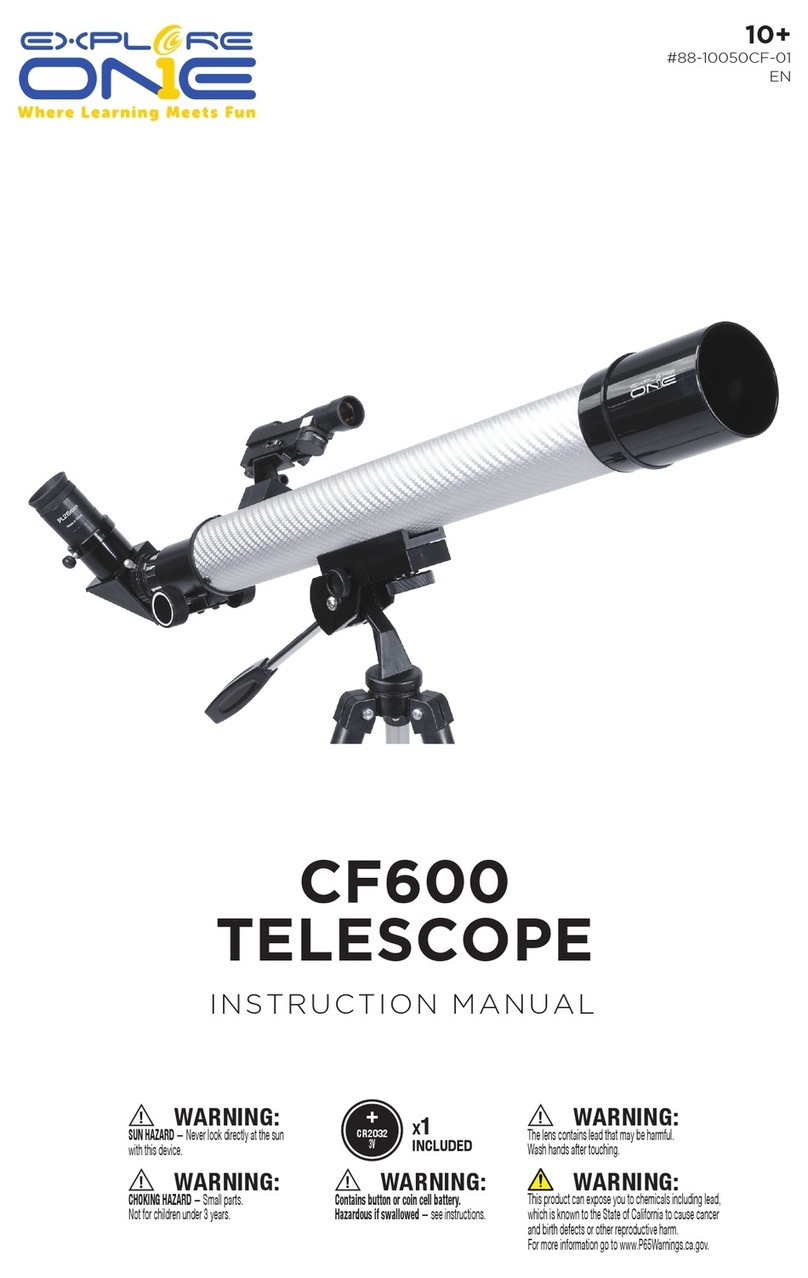
Explore One
Explore One CF600 User manual
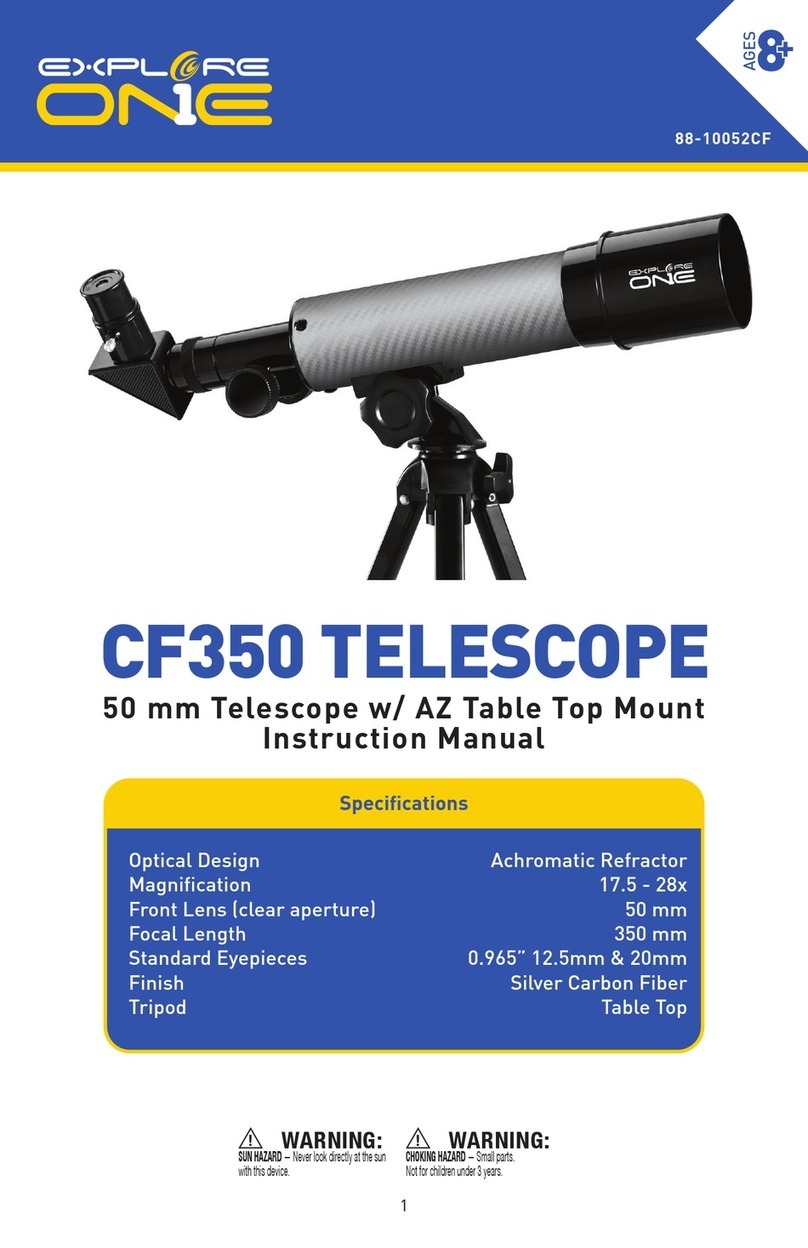
Explore One
Explore One CF350 User manual
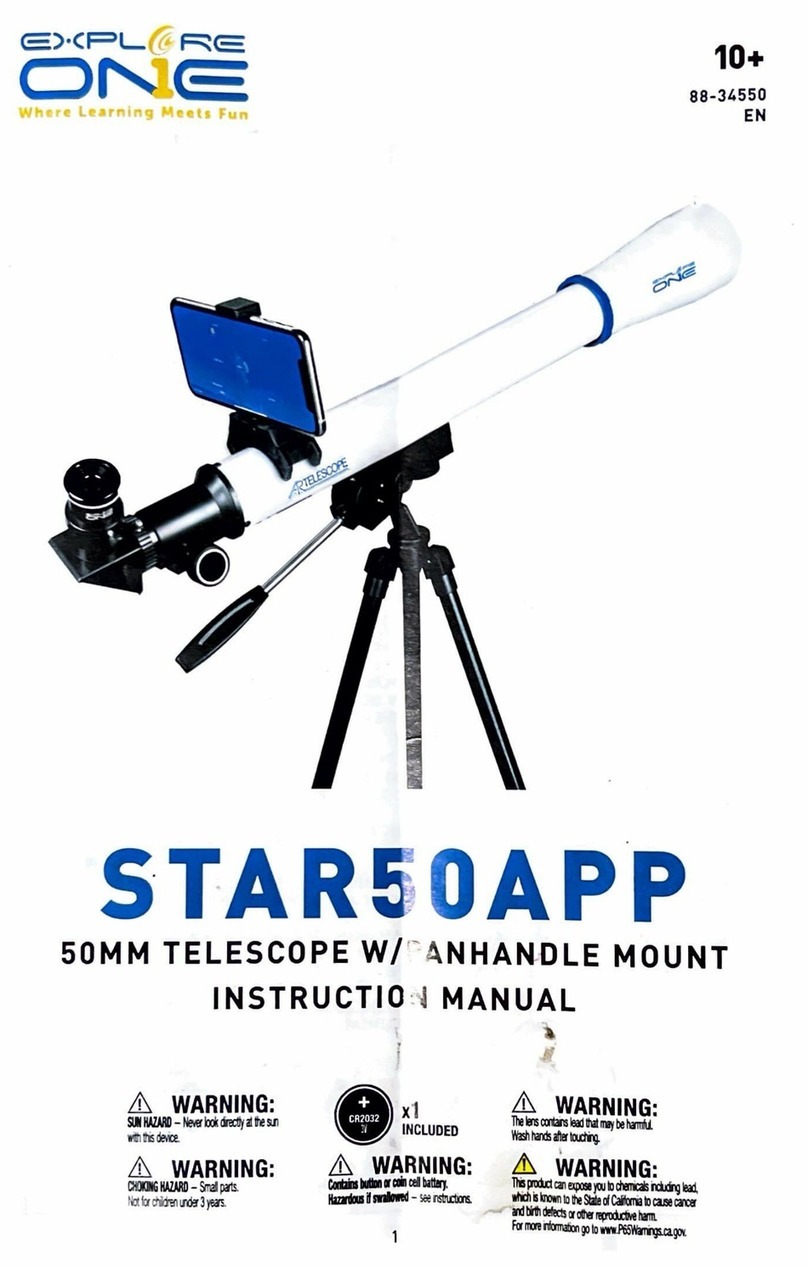
Explore One
Explore One STAR50APP User manual
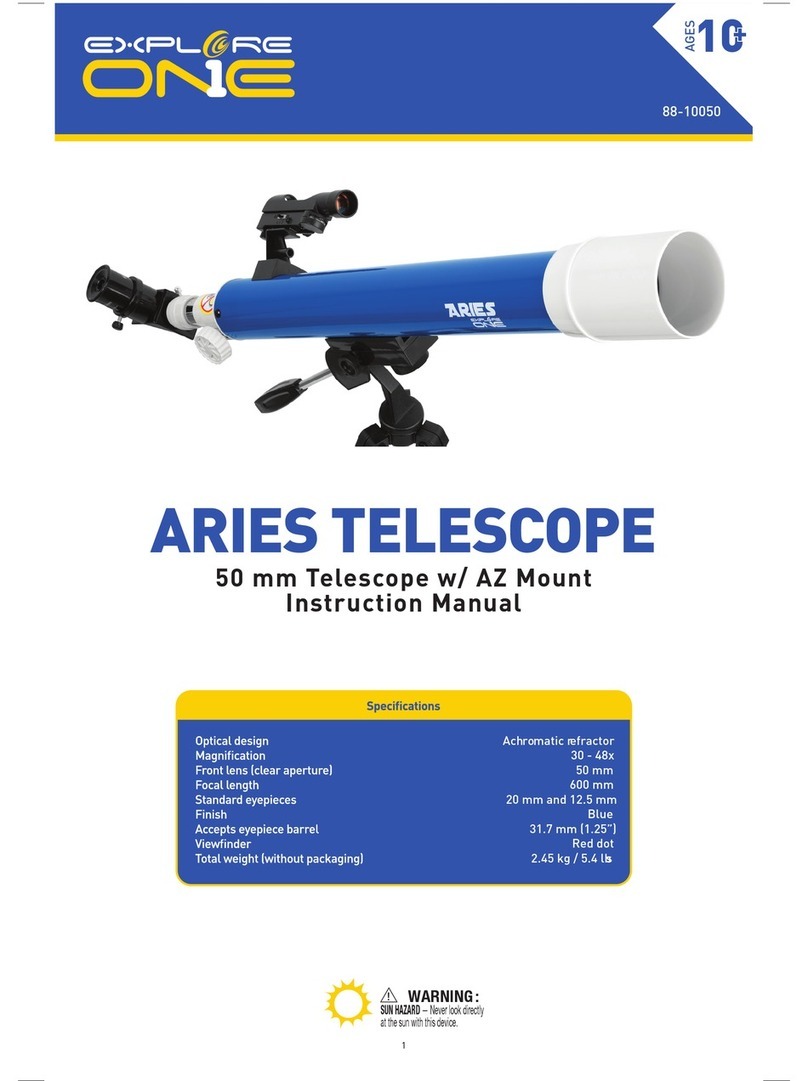
Explore One
Explore One ARIES 88-10050 User manual

Explore One
Explore One CF400 User manual

Explore One
Explore One CF400SP User manual
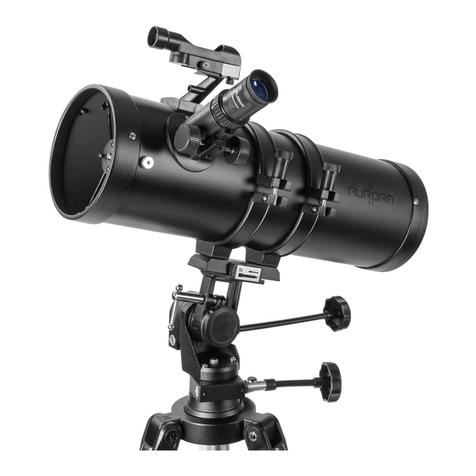
Explore One
Explore One Aurora II User manual
